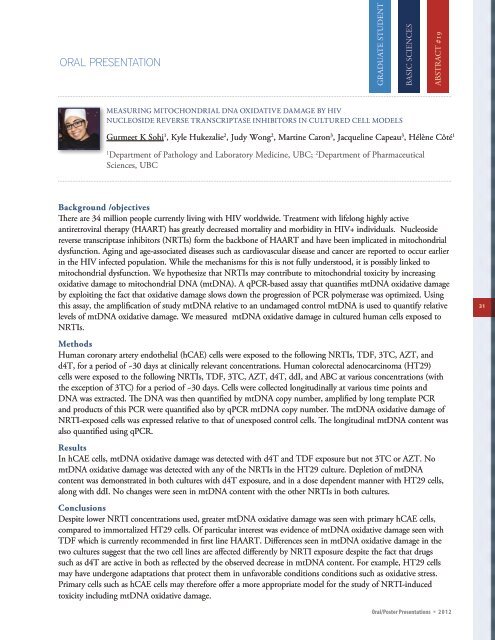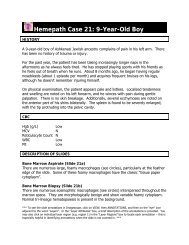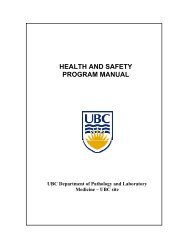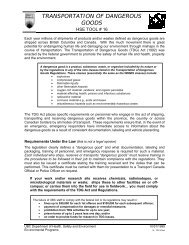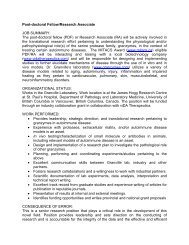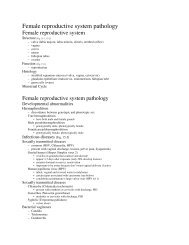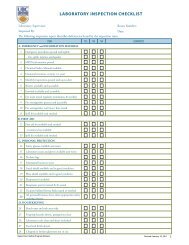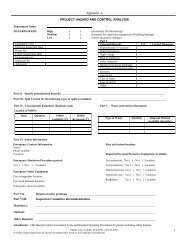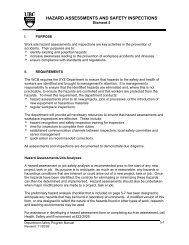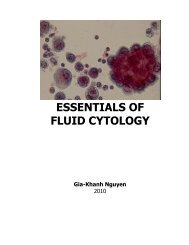Abstract Book - Pathology and Laboratory Medicine - University of ...
Abstract Book - Pathology and Laboratory Medicine - University of ...
Abstract Book - Pathology and Laboratory Medicine - University of ...
You also want an ePaper? Increase the reach of your titles
YUMPU automatically turns print PDFs into web optimized ePapers that Google loves.
oral presentationGRADUATE STUDENTBASIC SCIENCESABSTRACT #19Measuring mitochondrial DNA oxidative damage by HIVnucleoside reverse transcriptase inhibitors in cultured cell modelsGurmeet K Sohi 1 , Kyle Hukezalie 2 , Judy Wong 2 , Martine Caron 3 , Jacqueline Capeau 3 , Hélène Côté 11Department <strong>of</strong> <strong>Pathology</strong> <strong>and</strong> <strong>Laboratory</strong> <strong>Medicine</strong>, UBC; 2 Department <strong>of</strong> PharmaceuticalSciences, UBCBackground /objectivesThere are 34 million people currently living with HIV worldwide. Treatment with lifelong highly activeantiretroviral therapy (HAART) has greatly decreased mortality <strong>and</strong> morbidity in HIV+ individuals. Nucleosidereverse transcriptase inhibitors (NRTIs) form the backbone <strong>of</strong> HAART <strong>and</strong> have been implicated in mitochondrialdysfunction. Aging <strong>and</strong> age-associated diseases such as cardiovascular disease <strong>and</strong> cancer are reported to occur earlierin the HIV infected population. While the mechanisms for this is not fully understood, it is possibly linked tomitochondrial dysfunction. We hypothesize that NRTIs may contribute to mitochondrial toxicity by increasingoxidative damage to mitochondrial DNA (mtDNA). A qPCR-based assay that quantifies mtDNA oxidative damageby exploiting the fact that oxidative damage slows down the progression <strong>of</strong> PCR polymerase was optimized. Usingthis assay, the amplification <strong>of</strong> study mtDNA relative to an undamaged control mtDNA is used to quantify relativelevels <strong>of</strong> mtDNA oxidative damage. We measured mtDNA oxidative damage in cultured human cells exposed toNRTIs.MethodsHuman coronary artery endothelial (hCAE) cells were exposed to the following NRTIs, TDF, 3TC, AZT, <strong>and</strong>d4T, for a period <strong>of</strong> ~30 days at clinically relevant concentrations. Human colorectal adenocarcinoma (HT29)cells were exposed to the following NRTIs, TDF, 3TC, AZT, d4T, ddI, <strong>and</strong> ABC at various concentrations (withthe exception <strong>of</strong> 3TC) for a period <strong>of</strong> ~30 days. Cells were collected longitudinally at various time points <strong>and</strong>DNA was extracted. The DNA was then quantified by mtDNA copy number, amplified by long template PCR<strong>and</strong> products <strong>of</strong> this PCR were quantified also by qPCR mtDNA copy number. The mtDNA oxidative damage <strong>of</strong>NRTI-exposed cells was expressed relative to that <strong>of</strong> unexposed control cells. The longitudinal mtDNA content wasalso quantified using qPCR.ResultsIn hCAE cells, mtDNA oxidative damage was detected with d4T <strong>and</strong> TDF exposure but not 3TC or AZT. NomtDNA oxidative damage was detected with any <strong>of</strong> the NRTIs in the HT29 culture. Depletion <strong>of</strong> mtDNAcontent was demonstrated in both cultures with d4T exposure, <strong>and</strong> in a dose dependent manner with HT29 cells,along with ddI. No changes were seen in mtDNA content with the other NRTIs in both cultures.ConclusionsDespite lower NRTI concentrations used, greater mtDNA oxidative damage was seen with primary hCAE cells,compared to immortalized HT29 cells. Of particular interest was evidence <strong>of</strong> mtDNA oxidative damage seen withTDF which is currently recommended in first line HAART. Differences seen in mtDNA oxidative damage in thetwo cultures suggest that the two cell lines are affected differently by NRTI exposure despite the fact that drugssuch as d4T are active in both as reflected by the observed decrease in mtDNA content. For example, HT29 cellsmay have undergone adaptations that protect them in unfavorable conditions conditions such as oxidative stress.Primary cells such as hCAE cells may therefore <strong>of</strong>fer a more appropriate model for the study <strong>of</strong> NRTI-inducedtoxicity including mtDNA oxidative damage.Oral/Poster Presentations * 2012 31


